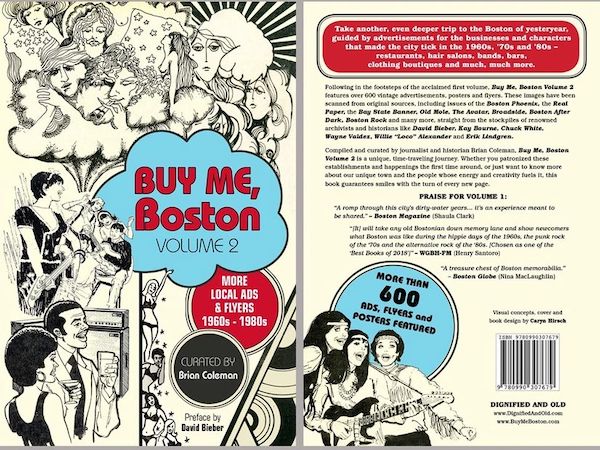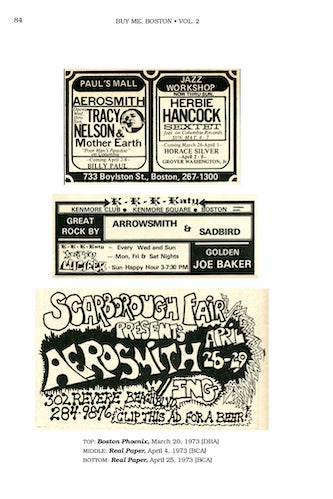Book Review: “Buy Me Boston, Volume 2” — Celebration of Advertisements Past
By Chelsea Spear
Flipping through this volume will help readers understand just how much the internet and consumer technology has changed the world of arts and culture.
Buy Me Boston, Volume 2 by Brian Coleman. Preface by David Bieber. Good Road, 300 pages. $17.98.

As a kid in the 1980s and ’90s, I looked forward to adulthood in Boston. I listened to local radio stations like WBCN, WBZ, and WFNX, excited about the cultural happenings in our city. Reading about local rock bands, nightclubs, and galleries in the Boston Phoenix or in the Arts & Films and Calendar sections of the Globe inspired daydreams of a future when I could see my favorite rock bands any day of the week. Now that Boston has become a world-class city for tech and pharmaceutical innovation, much of what fueled my teenage reveries has gone defunct or evolved into the downright unrecognizable.
Archivist Brian Coleman is nothing if not wistful about the vanished media ecosystem of Beantown in the late 20th century. And that nostalgia powered Buy Me, Boston, a 2018 compilation of newspaper and magazine ads from the city’s golden years. The book was so successful that it connected Coleman to a wider pool of archivists who represented different neighborhoods, scenes, and eras of Boston. That meant access to a more diverse array of ephemera from the hub’s past. Thus was born a second volume of local print ads, Buy Me, Boston, Volume 2.
The sequel stays true to Coleman’s “exploded fanzine” concept for the first book. Ads from different eras and businesses are laid out across the pages with no context beyond the publication name and date. Some of the ads are professionally photographed, meticulously laid out, and typeset. Others — such as the early Newbury Comics ads — feature crude line drawings and hand-scrawled dates and locations. How does Buy Me, Boston Volume 2 differ from its predecessor? There’s a greater focus on underground publications of the ’60s and ’70s, including gorgeous, full-color reproductions of ads for Mel Lyman’s notorious Avatar broadside, The People’s Yellow Pages, and WEEI-FM Stereo 103. The fluid lines, unusual fonts, solarized photography, and high-contrast op-art illustrations may well make readers long for an era they weren’t around for.
Flipping through the book also helps readers understand just how much the internet and consumer technology has changed the world of arts and culture. Ads for recording studios, management and public relations firms, record stores, and what we now call terrestrial radio stations stand out. This is partly because they are scarce today, given that enterprising bands and artists can record an album and make it a hit on their iPhones without it getting a second of airplay on the radio. Ads for specialty TV shows, social clubs, or retail stores have been subsumed by social media accounts or Substack newsletters.

That so many businesses and de facto community centers are all but obsolete adds to Buy Me Boston, Volume 2’s almost unbearably poignant undercurrent. Check out the book’s addresses: you will see photos of banks, chain stores, or vape shops where beloved independent businesses once stood. Paging through this volume at the height of the COVID-19 crisis not only shows us how much Boston has lost, but how much we stand to lose as the pandemic rages on. While Boston has improved in many ways since the turn of the 20th century, we’ve lost some of the personality, the individuality, of what made this city a unique place to live.
In his introduction, Coleman notes the inconsistent image quality. This might seem like a flaw, but the yellowed, tattered images have an almost tactile quality that underscores the project’s way-back-when perspective. “Brian has given the ads within his books a future, a place in history, an unexpected timelessness,” archivist David Bieber notes in the preface. Readers see not only the aesthetics of an earlier era, but how a city with a puritanical history like Boston’s engaged with progressive trends like the anti-ar movement of the ’60s or the punk uprising of the ’80s.
When I look back on my teenage years and what made me want to live in Boston, the local arts and music scene, along with the media ecosystem, made it seem like an exciting place to live. Hearing my favorite bands in regular rotation on local radio stations and buying their records at Strawberries or Newbury Comics, seeing hyper-local TV shows like We Don’t Knock or Ask the Manager, made Boston seem pretty cool. Oliver Wendell Holmes’s Hub of the Solar System has given way to the “Innovation Hub.” A more productive economy and the increasing nationalization of the media has come with a tragic price — the end of our local media, local music, and local retailers, invaluable places and people that fostered a community that gave Boston its distinctive personality, its unique flavor. (For more on the march of urban homogenization across America see the Arts Fuse‘s review of the late Scott Timberg’s book Culture Crash: The Killing of the Creative Class and the interview with the author.)
Bieber closes his preface with cheer, noting that “old ads are new news — elevated, celebrated, and venerated.” We see the kind of city Boston once was in Buy Me, Boston Volume 2. By looking at how the local press and TV stations once sold their wares — before a corporate mentality became dominant — we might glimpse ways to revive the healthy idiosyncrasy recalled so lovingly here. Coleman has done us a service by making these advertisements available.
Chelsea Spear has written for the Brattle Theatre’s Film Notes blog, the Gay & Lesbian Review, and Crooked Marquee. She lives in Boston.
